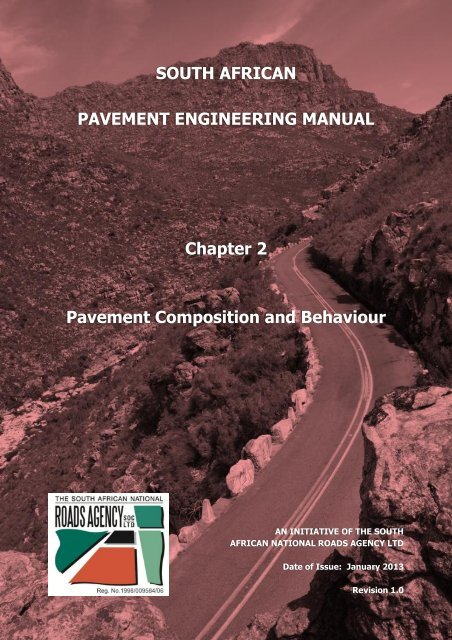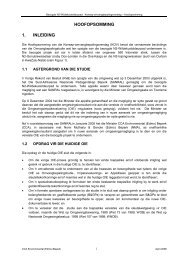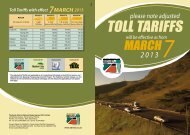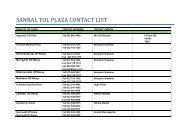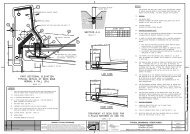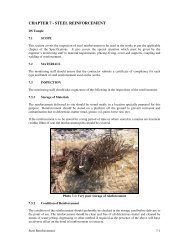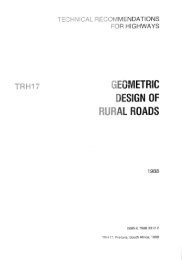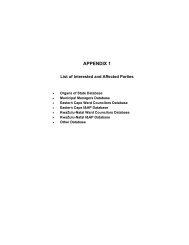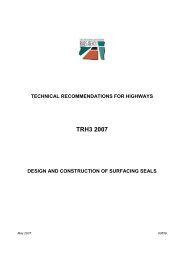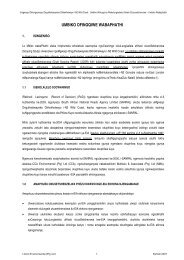SAPEM Chapter 2 - Sanral
SAPEM Chapter 2 - Sanral
SAPEM Chapter 2 - Sanral
Create successful ePaper yourself
Turn your PDF publications into a flip-book with our unique Google optimized e-Paper software.
SOUTH AFRICAN<br />
PAVEMENT ENGINEERING MANUAL<br />
<strong>Chapter</strong> 2<br />
Pavement Composition and Behaviour<br />
AN INITIATIVE OF THE SOUTH<br />
AFRICAN NATIONAL ROADS AGENCY LTD<br />
Date of Issue: January 2013<br />
Revision 1.0
South African Pavement Engineering Manual<br />
<strong>Chapter</strong> 2: Pavement Composition and Behaviour<br />
© 2013 South African National Roads Agency Ltd. All rights reserved.<br />
First edition published 2013<br />
Printed in the Republic of South Africa<br />
SET: ISBN 978-1-920611-00-2<br />
CHAPTER: ISBN 978-1-920611-02-6<br />
www.nra.co.za<br />
sapem@nra.co.za
SOUTH AFRICAN<br />
PAVEMENT ENGINEERING MANUAL<br />
<strong>Chapter</strong> 2<br />
Pavement Composition and Behaviour<br />
AN INITIATIVE OF THE SOUTH<br />
AFRICAN NATIONAL ROADS AGENCY LTD<br />
Date of Issue: January 2013<br />
Revision 1.0
BACKGROUND<br />
<br />
You are<br />
here<br />
1. Introduction<br />
2. Pavement Composition and Behaviour<br />
TESTING AND LABORATORY<br />
3. Materials Testing<br />
4. Standards<br />
5. Laboratory Management<br />
INVESTIGATION<br />
6. Road Prism and Pavement Investigations<br />
7. Geotechnical Investigations and Design Considerations<br />
8. Material Sources<br />
DESIGN<br />
9. Materials Utilisation and Design<br />
10. Pavement Design<br />
DOCUMENTATION AND TENDERING<br />
11. Documentation and Tendering<br />
IMPLEMENTATION<br />
12. Construction Equipment and Method Guidelines<br />
QUALITY MANAGEMENT<br />
13. Acceptance Control<br />
POST CONSTRUCTION<br />
14. Post-Construction
South African Pavement Engineering Manual<br />
<strong>Chapter</strong> 2: Pavement Composition and Behaviour<br />
CHAPTER CONTEXT<br />
The South African Pavement Engineering Manual (<strong>SAPEM</strong>) is a reference manual for all aspects of pavement<br />
engineering. <strong>SAPEM</strong> is a best practice guide. There are many appropriate manuals and guidelines available for<br />
pavement engineering, which <strong>SAPEM</strong> does not replace. Rather, <strong>SAPEM</strong> provides details on these references, and<br />
where necessary, provides guidelines on their appropriate use. Where a topic is adequately covered in another<br />
guideline, the reference is provided. <strong>SAPEM</strong> strives to provide explanations of the basic concepts and terminology<br />
used in pavement engineering, and provides background information to the concepts and theories commonly used.<br />
<strong>SAPEM</strong> is appropriate for use at National, Provincial and Municipal level, as well as in the Metros. <strong>SAPEM</strong> is a<br />
valuable education and training tool, and is recommended reading for all entry level engineers, technologists and<br />
technicians involved in the pavement engineering industry. <strong>SAPEM</strong> is also useful for practising engineers who would<br />
like to access the latest appropriate reference guideline.<br />
<strong>SAPEM</strong> consists of 14 chapters. A brief description of each chapter is given below to provide the context for this<br />
chapter, <strong>Chapter</strong> 2.<br />
<strong>Chapter</strong> 1: Introduction discusses the application of this <strong>SAPEM</strong> manual, and the institutional responsibilities,<br />
statutory requirements, and, planning and time scheduling for pavement engineering projects. A glossary of terms<br />
and abbreviations used in all the <strong>SAPEM</strong> chapters is included in Appendix A.<br />
<strong>Chapter</strong> 2: Pavement Composition and Behaviour includes the history of roads from Roman times to modern<br />
roads, and the basic principles of roads, from political and technical perspectives. Typical pavement structures,<br />
material characteristics and pavement types, including both flexible and rigid pavements, and surfacings are given.<br />
The development of pavement distress is discussed (although more detail and illustrations are given in <strong>Chapter</strong> 14),<br />
along with the types of distresses usually associated with particular pavement types. The functional performance of<br />
pavements is also presented. As an introduction and background for reference with other chapters, particularly<br />
<strong>Chapter</strong> 10, the basic principles of mechanics of materials and material science are outlined. Climatic issues,<br />
variability in pavements and life-cycle strategies are also covered.<br />
<strong>Chapter</strong> 3: Materials Testing presents the tests used for all material types used in pavement structures. The<br />
tests are briefly described, and reference is made to the test number and where to obtain the full test method.<br />
Where possible and applicable, interesting observations or experiences with the tests are mentioned. <strong>Chapter</strong>s 3 and<br />
4 are complementary.<br />
<strong>Chapter</strong> 4: Standards follows the same format as <strong>Chapter</strong> 3, but discusses the standards used for the various<br />
tests. This includes applicable limits (minimum and maximum values) for test results. Material classification systems<br />
are given, as are guidelines on mix and materials composition.<br />
<strong>Chapter</strong> 5: Laboratory Management covers laboratory quality management, testing personnel, test methods,<br />
and the testing environment and equipment. Quality assurance issues, and health, safety and the environment are<br />
also discussed.<br />
<strong>Chapter</strong> 6: Road Prism and Pavement Investigation discusses all aspects of the road prism and pavement<br />
investigations, including legal and environmental requirements, materials testing, and the reporting of the<br />
investigations. <strong>Chapter</strong>s 6 and 7 are complementary.<br />
<strong>Chapter</strong> 7: Geotechnical Investigations and Design Considerations covers the investigations into potential<br />
problem subgrades, fills, cuts, structures and tunnels. Guidelines for the reporting of the investigations are provided.<br />
<strong>Chapter</strong> 8: Material Sources provides information for sourcing materials from project quarries and borrow pits,<br />
commercial materials sources and alternative sources.<br />
<strong>Chapter</strong> 9: Materials Utilisation and Design discusses materials in the roadbed, earthworks (including cuts and<br />
fills) and all the pavement layers, including soils and gravels, crushed stones, cementitious materials, primes, stone<br />
precoating fluids and tack coats, bituminous binders, bitumen stabilised materials, asphalt, spray seals and micro<br />
surfacings, concrete, proprietary and certified products and block paving. The mix designs of all materials are<br />
discussed.<br />
<strong>Chapter</strong> 10: Pavement Design presents the philosophy of pavement design, methods of estimating design traffic<br />
and the pavement investigation process. Methods of structural capacity estimation for flexible, rigid and concrete<br />
block pavements are discussed.<br />
Preliminary Section<br />
Page ii
South African Pavement Engineering Manual<br />
<strong>Chapter</strong> 2: Pavement Composition and Behaviour<br />
<strong>Chapter</strong> 11: Documentation and Tendering covers the different forms of contracts typical for road pavement<br />
projects; the design, contract and tender documentation; and, the tender process.<br />
<strong>Chapter</strong> 12: Construction Equipment and Method Guidelines presents the nature and requirements of<br />
construction equipment and different methods of construction. The construction of trial sections is also discussed.<br />
<strong>Chapter</strong>s 12 and 13 are complementary<br />
<strong>Chapter</strong> 13: Quality Management includes acceptance control processes, and quality plans. All the pavement<br />
layers and the road prism are discussed. The documentation involved in quality management is also discussed, and<br />
where applicable, provided.<br />
<strong>Chapter</strong> 14: Post-Construction incorporates the monitoring of pavements during the service life, the causes and<br />
mechanisms of distress, and the concepts of maintenance, rehabilitation and reconstruction.<br />
FEEDBACK<br />
<strong>SAPEM</strong> is a “living document”. The first edition was made available in electronic format in January 2013. It is<br />
envisaged that <strong>SAPEM</strong> will be updated after one year. Feedback from all interested parties in industry is appreciated,<br />
as this will keep <strong>SAPEM</strong> appropriate.<br />
To provide feedback on <strong>SAPEM</strong>, please email sapem@nra.co.za.<br />
Preliminary Section<br />
Page iii
South African Pavement Engineering Manual<br />
<strong>Chapter</strong> 2: Pavement Composition and Behaviour<br />
ACKNOWLEDGEMENTS<br />
This compilation of this manual was funded by the South African National Road Agency Limited (SANRAL). The<br />
project was coordinated on behalf of SANRAL by Kobus van der Walt and Steph Bredenhann. Professor Kim Jenkins,<br />
the SANRAL Chair in Pavement Engineering at Stellenbosch University, was the project manager. The Cement and<br />
Concrete Institute (C & CI) provided administrative support.<br />
The following people contributed to the compilation of <strong>Chapter</strong> 2:<br />
Task Group Leader: Professor Kim Jenkins, Stellenbosch University<br />
Steph Bredenhann, SANRAL<br />
Dr Fenella Johns, Rubicon Solutions<br />
Arthur Taute, Vela VKE Consulting Engineers (Part of the SMEC Group)<br />
This <strong>SAPEM</strong> manual was edited by Dr Fenella Johns, Rubicon Solutions.<br />
Photos for this chapter were provided by:<br />
Dave Collings, UCD Technologies/Louden International<br />
Louw du Plessis, CSIR Built Environment<br />
Dr Arno Hefer, Rubicon Solutions<br />
Professor Kim Jenkins, Stellenbosch University<br />
Dr Phil Paige-Green, CSIR Built Environment<br />
Bryan Perrie, Cement and Concrete Institute (C & CI)<br />
Preliminary Section<br />
Page iv
South African Pavement Engineering Manual<br />
<strong>Chapter</strong> 2: Pavement Composition and Behaviour<br />
TABLE OF CONTENTS<br />
1. Introduction ....................................................................................................................................... 1<br />
2. History ................................................................................................................................................ 2<br />
2.1 Development of Roads ................................................................................................................. 2<br />
2.2 History of Pavement Design .......................................................................................................... 4<br />
2.2.1 AASHO Road Test .............................................................................................................. 5<br />
2.3 Necessity of Roads ....................................................................................................................... 6<br />
3. Basic Principles of Roads ................................................................................................................... 8<br />
3.1 Political Pyramid .......................................................................................................................... 8<br />
3.2 Technical Pyramid ........................................................................................................................ 8<br />
4. Pavement Structure ......................................................................................................................... 10<br />
4.1 Pavement Design ....................................................................................................................... 10<br />
5. Material Characteristics ................................................................................................................... 11<br />
6. Pavement Types ............................................................................................................................... 14<br />
6.1 Types of Surfacing ..................................................................................................................... 15<br />
6.1.1 Flexible Pavements .......................................................................................................... 15<br />
6.1.2 Rigid Pavements .............................................................................................................. 17<br />
7. Pavement Distress ............................................................................................................................ 19<br />
7.1 Accumulation of Distress ............................................................................................................ 20<br />
8. Functional Performance ................................................................................................................... 22<br />
9. Mechanics of Materials (Stresses and Strains)................................................................................ 24<br />
9.1 Definitions of Stress and Strain ................................................................................................... 24<br />
9.2 Normal and Shear Stresses and Strains ........................................................................................ 24<br />
9.3 Mechanistic Pavement Analysis ................................................................................................... 26<br />
10. Material Science ............................................................................................................................... 28<br />
10.1 Elasticity ................................................................................................................................... 28<br />
10.1.1 Poisson’s Ratio ................................................................................................................ 29<br />
10.2 Plasticity ................................................................................................................................... 30<br />
10.3 Viscosity.................................................................................................................................... 31<br />
11. Climate .............................................................................................................................................. 33<br />
12. Variability ......................................................................................................................................... 35<br />
13. Life Cycle Strategy ........................................................................................................................... 36<br />
References and Bibliography ..................................................................................................................... 38<br />
Preliminary Section<br />
Page v
South African Pavement Engineering Manual<br />
<strong>Chapter</strong> 2: Pavement Composition and Behaviour<br />
LIST OF TABLES<br />
Table 1. Classification of Pavements Based on Application and Traffic ......................................................... 14<br />
Table 2. Road User Needs, Functional Parameters and Behaviour Measurements ......................................... 22<br />
Table 3. Typical Poisson Ratio Values ....................................................................................................... 30<br />
LIST OF FIGURES<br />
Figure 1. Typical Roman Pavement (McCauley, 1974) ................................................................................... 2<br />
Figure 2. Pavement Structure ..................................................................................................................... 3<br />
Figure 3. Bain’s Kloof Pass .......................................................................................................................... 4<br />
Figure 4. Conceptual Impact of Technological Developments on Roads ........................................................... 4<br />
Figure 5. Impassable Unsurfaced Roads Due to Wet Conditions, Early 20 th Century ......................................... 5<br />
Figure 6. AASHO Road Test (AASHTO, 1961) ............................................................................................... 6<br />
Figure 7. Road Concepts Political and Technical Pyramids for Roads ............................................................... 8<br />
Figure 8. Typical Pavement Structures ....................................................................................................... 10<br />
Figure 9. Example Cross-sections of the Typical Pavement Materials ............................................................ 12<br />
Figure 10. Expected Behaviour of Material Types as a Function of Bitumen and Active Filler Content ................. 13<br />
Figure 11. Classification of Pavement Types based on Materials ..................................................................... 14<br />
Figure 12. Schematic Illustration of Seal Types (a) ....................................................................................... 16<br />
Figure 12. Schematic Illustrations of Seal Types (b) ...................................................................................... 17<br />
Figure 13. Schematic Illustrations of the Types of Rigid Pavements ................................................................ 18<br />
Figure 14. Evolution of Failure Mechanisms with Time and Loading ................................................................ 20<br />
Figure 15. Structural Performance Incorporated into Pavement Condition ....................................................... 21<br />
Figure 16. Pumping of Stabilised Base ......................................................................................................... 22<br />
Figure 17. Surface Cracking and Potholing ................................................................................................... 23<br />
Figure 18. Functional Performance for Different Road Structures ................................................................... 23<br />
Figure 19. Force Applied to an Element of Material ....................................................................................... 24<br />
Figure 20. Normal Stresses ......................................................................................................................... 25<br />
Figure 21. Volume and Shape Changes ........................................................................................................ 25<br />
Figure 22. Principal Stresses ....................................................................................................................... 25<br />
Figure 23. Conceptual Bending Model for a Bound Layer on Unbound Support ................................................ 27<br />
Figure 24. Conceptual Model of Stress-Distribution for Unbound Layer on Unbound Support ............................ 27<br />
Figure 25. Elastic Response to a Load, Sustain, Unload Cycle ........................................................................ 28<br />
Figure 26. Elastic Modulus as a Function of Stress and Strain ........................................................................ 29<br />
Figure 27. Poisson’s Ratio () ..................................................................................................................... 29<br />
Figure 28. Plastic Response to a Load, Sustain, Unload Cycle ........................................................................ 30<br />
Figure 29. Elasto-plastic Behaviour and Resilient Modulus ............................................................................. 31<br />
Figure 30. Viscous Response to a Load, Sustain, Unload Cycle ....................................................................... 32<br />
Figure 31. Thornthwaite’s Moisture Index for Southern Africa ........................................................................ 33<br />
Figure 32. Minimum Asphalt Design Temperature on Surface ........................................................................ 34<br />
Figure 33. Maximum Asphalt Design Temperature at 20 mm Below Surface .................................................... 34<br />
Figure 34. Pavement Deterioration with a Heavy Rehabilitation Strategy ......................................................... 36<br />
Figure 35. Pavement Deterioration with a Frequent Maintenance Strategy ...................................................... 36<br />
Figure 36. Impact of Timeous Maintenance on Life Cycle Costs...................................................................... 37<br />
Preliminary Section<br />
Page vi
South African Pavement Engineering Manual<br />
<strong>Chapter</strong> 2: Pavement Composition and Behaviour<br />
1. INTRODUCTION<br />
This chapter lays the foundation for the other chapters of <strong>SAPEM</strong>, and provides much of the background information<br />
required to understand the elements that go into pavement engineering. The chapter starts with the history of roads<br />
and continues with the basic principles of roads. The rationale behind the structures used for pavements, and typical<br />
pavement structures are presented, including the types and characteristics of materials used in typical pavements. A<br />
section on material science is included, to explain the concepts used when analysing pavement structures. The<br />
chapter ends with sections on climate, variability and life cycle strategy.<br />
Section 1: Introduction<br />
Page 1
South African Pavement Engineering Manual<br />
<strong>Chapter</strong> 2: Pavement Composition and Behaviour<br />
2. HISTORY<br />
This section looks at the history of roads, from their development, to the history of pavement design. The necessity<br />
of roads is also discussed.<br />
2.1 Development of Roads<br />
An understanding of how pavement technology evolved requires a look back into the historical developments of<br />
roads. In ancient times there was nothing more than a sparse network of tracks for humans to reach feeding and<br />
drinking places. These tracks differed only slightly from the tracks made by the movement of foraging animals. The<br />
primary difference was that obstacles, e.g., boulders, were removed from the more important routes and thorn<br />
bushes were trimmed back by humans. More elaborate lines of communication than these simple tracks did not<br />
appear until the number of humans in certain areas reached a stage where their social structures and networks<br />
demanded more permanent contact between communities.<br />
Roads thus appeared when groups of people started to interact with each other by travelling, doing business,<br />
fighting, and socializing. This occurred around 3500 BC. At this time, the invention of the wheel and development of<br />
chariots and wagons showed that the existing soil or subgrade on the interlinking routes was inadequate. Layers of<br />
better quality material were required to protect the subgrade, giving rise to the pavement structure.<br />
The earliest records of paved roads for wheeled traffic date from about 2200 BC in Babylonia (modern Iraq), in Crete<br />
from about 1500 BC and in Egypt from about 540 BC. In Europe, the first substantial roads were built by the<br />
Romans, with a network of more than 100 000 kilometres of road built between 400 BC and 400 AD. The Roman<br />
roads were cambered to shed rainwater and were constructed on a foundation of large stones with a wearing course<br />
of smaller stones and gravel, constrained between raised stone kerbs, as illustrated in Figure 1.<br />
Figure 2.2. Typical<br />
Roman Pavement<br />
Figure 1. Typical Roman Pavement (McCauley, 1974)<br />
The Romans were the best road builders of the remote ages. Conquests achieved through war games were one of<br />
the reasons for this. The Romans needed a good network of roads to control their conquered subject-nations. The<br />
army needed to be able to move fast to quell any revolting groups. The Roman roads were cobbled with a base<br />
system that was dependent on the subgrade. They developed a three or four layer system, illustrated in Figure 2,<br />
consisting of:<br />
Top layer<br />
Base, sometimes stabilised<br />
Subbase<br />
Subgrade<br />
Section 2: History<br />
Page 2
South African Pavement Engineering Manual<br />
<strong>Chapter</strong> 2: Pavement Composition and Behaviour<br />
Figure 2.<br />
Pavement Structure<br />
Napoleon was responsible for the construction of a considerable network of roads in Europe in the late 18 th and early<br />
19 th centuries. In 1747, the “Ecole des Ponts et Chaussess” was founded in Paris, France. In 1765, Tresaguet<br />
developed the Roman road structure further. His basic principle was to construct the first layer with big blocks and<br />
then to place little rocks in between. By doing this, he attempted to ensure that the first layer was consistently<br />
subjected to compressive stresses and improved load spreading on the subgrade was achieved.<br />
At the same time, in about 1810 in England, people such as Telford and Metcalf made valuable developments,<br />
including:<br />
Design of drainage<br />
Design of the road camber<br />
Active and regular maintenance<br />
Telford and Metcalf found that through drainage design and the inclusion of a crossfall, maintenance could be<br />
substantially reduced and the required layer thickness dramatically reduced.<br />
In Great Britain, the Industrial Revolution required a road building programme for the movement of materials and<br />
goods, and many kilometres of road were built by various means. During this time, Macadam (1756 to 1836)<br />
invented a method of road building as follows: after careful preparation and draining of the roadbed (or subgrade),<br />
he laid a 25 cm layer of stone (aggregate size that could fit in a man’s mouth), followed by a surfacing of smaller<br />
stones. This type of roadway was ideal for animal drawn wagons and coaches, and was cheap to build. John<br />
Macadam’s roads lasted well under traffic and many British roads were “macadamised”. They were a good solution in<br />
the nineteenth century for iron rimmed wheels, i.e., treads.<br />
However, the invention of motorised transport by Marcus, who invented the first car with traction in Vienna in about<br />
1870, and rubber tyres developed by Dunlop in 1888, changed the requirements once again. Speeds increased,<br />
making safety an important consideration. Rubber-tyred wheels “sucked” the dust from the road surface, loosening<br />
the stones and causing blinding clouds of dust. Hence, in the early part of the 20 th century, tar was spread over the<br />
road surface to hold the stones in place and to prevent dust. Sand, stone and tar formed a “surface dressing”. Later<br />
the “tar-macadam” surface of stone coated with tar and rolled to a smooth surface was used, hence the term<br />
tarmac. Today we still make waterbound macadam, washing sand into the interstices between the larger stones and<br />
penetration macadam by vibrating bitumen-emulsion slurry into the interstices.<br />
In South Africa, the pioneer road-builder was Thomas Bain (1830 – 1893), son of Andrew Geddes Bain. Thomas Bain<br />
constructed 23 major mountain passes, nearly all in the Cape Province. Some of his roads are still in use today, e.g.,<br />
Bain’s Kloof Pass, shown in Figure 3. The book “Romance of the Cape Mountain Passes” by Dr G. Ross provides<br />
interesting facts about this era of road construction.<br />
Some other important developments in the nineteenth century included the train and as a result of technical<br />
breakthroughs, the steamroller (a roller powered by steam). Much attention went on the development of the train<br />
and in many countries, with a focus on building new railway lines, the roads deteriorated. In 1863, Lemoine<br />
invented the two-wheel steamroller, and at the same time Clark and Butler developed the three-wheeled steamroller.<br />
This made compaction of granular layers significantly easier and the quality of compaction increased. The impact of<br />
changes in technology on the development of roads is conceptualised in Figure 4.<br />
Section 2: History<br />
Page 3
South African Pavement Engineering Manual<br />
<strong>Chapter</strong> 2: Pavement Composition and Behaviour<br />
Figure 3.<br />
Bain’s Kloof Pass<br />
Advances in<br />
technology<br />
Maximum<br />
aggregate size<br />
Traffic<br />
Vehicle<br />
technology<br />
Motorisation<br />
Equipment<br />
The Wheel<br />
2000<br />
BC<br />
500<br />
BC<br />
500<br />
AD<br />
1800<br />
AD<br />
2000<br />
AD<br />
Time<br />
Mesopotamian<br />
Persian<br />
Roman<br />
Middle Ages<br />
Modern<br />
Figure 4.<br />
Conceptual Impact of Technological Developments on Roads<br />
2.2 History of Pavement Design<br />
Prior to the early 1920s, the thickness of pavements was based purely on experience. The invention of the car and<br />
the introduction by Henry Ford of his Model T-Ford in 1908 gave a strong impetus to look at the design of roads<br />
more seriously. Twenty million Model T Fords were sold between 1908 and 1927. The traction of a car, i.e., the<br />
Section 2: History<br />
Page 4
South African Pavement Engineering Manual<br />
<strong>Chapter</strong> 2: Pavement Composition and Behaviour<br />
friction between tyre and road, damages the surface and unpaved roads could not cater for this. This resulted in use<br />
of the following in the 20 th century:<br />
Empirical design systems: experience- and observation-based designs<br />
Mechanistic design systems: linking performance to critical pavement properties and failure mechanisms<br />
Mechanistic-empirical design systems: linking critical pavement properties to experience based limits<br />
In Scotland and Ohio, expensive solutions were found through experimentation. At the same time, experiments were<br />
undertaken to investigate tar or natural asphalt, found in a lake in Trinidad, and split (aggregate). Skid resistance<br />
and a lack of bond to existing layers, proved problematic. Typical problems of the time, which included impassibility<br />
of many unsurfaced roads in wet conditions, can be seen in Figure 5, taken from Floor (1985).<br />
Figure 5.<br />
Impassable Unsurfaced Roads Due to Wet Conditions, Early 20 th Century<br />
In the period between the First and Second World Wars, the growing importance of roads drove necessary<br />
improvements in pavement design. After the Second World War, the growth in traffic, loads and tyre pressures, and<br />
the higher speeds, necessitated the development of pavement technology beyond empiricism or designs based on<br />
experience only. Functional performance had to be defined, being the basis of the service that is provided to the road<br />
users in relation to the cost. This is indicative of fitness for use. Performance also needed to be better understood<br />
and more predictable. This required knowledge of structural behaviour and pavement distress in relation to time.<br />
This motivated the AASHO road test.<br />
2.2.1 AASHO Road Test<br />
The AASHO Road Test took place in Ottawa, Illinois about 100 km south-west of Chicago between 1956 and 1958. It<br />
was an enormous effort to systematically quantify the complex interaction between road deterioration, traffic and<br />
composition of the pavement structure on a closed loop test track with trucks. The test track is illustrated in Figure 6.<br />
AASHO stands for American Association of State Highway Officials and later became AASHTO (Highway and<br />
Transportation).<br />
The aims of the AASHO road test are still very relevant:<br />
Developing satisfactory pavement design procedures to meet the growing demands of traffic.<br />
Aid legislators in setting user taxation and control of vehicle size and weight.<br />
Section 2: History<br />
Page 5
South African Pavement Engineering Manual<br />
<strong>Chapter</strong> 2: Pavement Composition and Behaviour<br />
Figure 6. AASHO Road Test (AASHTO, 1961)<br />
The cost of the AASHO road test was $29 million in 1954 (equivalent to about $300 million in 1996). As a result of<br />
the experiment, for the first time the relationship between performance and loading was investigated. The main<br />
findings were:<br />
Definition of serviceability as the degree to which the road pavement serves the road users.<br />
Development of the Present Serviceability Rating (PSR), where road users rated the serviceability of various<br />
roads.<br />
Present Serviceability Index (PSI) was developed when it was shown<br />
that the PSR was more closely correlated with riding quality than with any<br />
other variable. Hence, it became possible to estimate the PSR from more<br />
objective measurements of roughness, rather than from subjective user<br />
ratings.<br />
The concept of load equivalency was defined where the equivalent<br />
damage caused by different axle loads and configurations was quantified<br />
relative to the 80 kN single axle that was the norm at the time. The<br />
AASHO road test showed that different equivalencies also existed for<br />
different pavement types (asphalt and concrete).<br />
The load equivalency factor is normally simplified using Equation (1):<br />
E80s & MESA<br />
An E80 is an equivalent 80 kN<br />
axle load. Typically, varying<br />
axle loads are converted to<br />
E80s using Equation 1.<br />
Another popular term is MESA,<br />
which is Million Equivalent<br />
Standard Axles.<br />
( ) (1)<br />
where<br />
LEF<br />
P<br />
80<br />
n<br />
=<br />
=<br />
=<br />
=<br />
Load equivalency factor, the relative damage caused by<br />
axle load P compared to a 80 kN single axle load<br />
Axle load (kN)<br />
Equivalent Standard Axle Load (ESAL or E80) in (kN)<br />
damage exponent<br />
The damage exponent depends on the pavement and distress type, but typically 4.2 is used for flexible pavements in<br />
South Africa. See <strong>Chapter</strong> 10, Section 4.1.3.<br />
A design method was developed from the results of the AASHO Road Test, known as the AASHTO Structural Number<br />
method (AASHTO, 1986). This method is discussed in <strong>Chapter</strong> 10, Section 7.4.<br />
2.3 Necessity of Roads<br />
In the modern world it is well known that apart from social factors such as transport to hospitals, quick access to a<br />
fire and emergencies, visiting friends and tourism, a good road system is the backbone for all kinds of economic<br />
activity.<br />
It is generally acknowledged that global competitiveness requires good road infrastructure. Rural road construction is<br />
enormously important and plays a major role in stimulating the economy (farm to market routes). This has been<br />
Section 2: History<br />
Page 6
South African Pavement Engineering Manual<br />
<strong>Chapter</strong> 2: Pavement Composition and Behaviour<br />
observed in many African countries, where agricultural and mining output increases by an order of magnitude<br />
through provision of new road infrastructure. Links to ports are especially important.<br />
The 21 st century has commenced with an emphasis on:<br />
Improvements in material science and introduction of specialist materials that provide enhanced performance<br />
e.g., polymer modified bitumen.<br />
An environmental focus that includes sustainable practice; minimal impact on the environment, i.e., minimising<br />
the carbon-footprint and recycling with minimal utilisation of non-renewable resources; and, permeable<br />
pavements to reduce run-off.<br />
New priorities and frameworks for procurement and road delivery, including the needs of developing areas,<br />
such as Public-Private-Partnering (PPP). See <strong>Chapter</strong> 11 for procurement and contracting.<br />
Increases in traffic volumes have resulted in the need for increased design pavement capacities. At the<br />
same time, design strategy has moved towards perpetual or long-life pavements. These pavements aim to<br />
provide structural capacity for 30 to 50 years with only functional maintenance requirements. It is necessary to<br />
adopt long-life pavements because the opportunities for maintenance and rehabilitation interventions are severely<br />
restricted for the following reasons:<br />
Road user costs, particularly costs relating to traffic delays, are exorbitant.<br />
Access to the road pavement is restricted, resulting in construction being carried out at night or over<br />
weekends.<br />
John F Kennedy<br />
“Building a road or highway isn’t<br />
pretty. But it is something that<br />
our economy needs to have!”<br />
Section 2: History<br />
Page 7
Abstraction level<br />
South African Pavement Engineering Manual<br />
<strong>Chapter</strong> 2: Pavement Composition and Behaviour<br />
3. BASIC PRINCIPLES OF ROADS<br />
The history of the development of roads shows that a shift in the paradigm of pavement technology occurred in the<br />
20 th century. Since then, the needs extend beyond the technical issues into the functional, environmental and<br />
political needs, and amplified with the advent and traffic motorization and growth. The Netherlands Roads Authority,<br />
Rijkswaterstaat, captured this trend in a pamphlet (Rijkswaterstaat, 1991) by providing an overview of the different<br />
abstraction levels for roads, using two pyramids, as shown in Figure 7.<br />
POLITICAL<br />
TECHNICAL<br />
HIGH<br />
ROAD USER<br />
NEEDS<br />
Level 1<br />
PUBLIC<br />
POLICY<br />
FUNCTIONAL<br />
PERFORMANCE<br />
Level 2<br />
TRAFFIC<br />
ROAD DESIGN<br />
MATERIALS<br />
PAVEMENT<br />
BEHAVIOUR<br />
MATERIAL RESPONSE<br />
TO LOADING<br />
Level 3<br />
Level 4<br />
LOW<br />
NATURE OF MATERIAL<br />
Level 5<br />
Figure 7.<br />
Road Concepts Political and Technical Pyramids for Roads<br />
3.1 Political Pyramid<br />
The political pyramid includes issues such as:<br />
The public is the customer whose perceptions, opinion and needs<br />
place high demands on road authorities. In turn, the road authorities<br />
have become more aware of their customers’ requirements.<br />
Policy related to road infrastructure evolves with changing social,<br />
economic and environmental needs, the “triple bottom line”. Examples<br />
include: Incentives for labour enhanced construction, or percentage<br />
labour component in contracts, toll roads (user pays principle) and<br />
carbon credits.<br />
Traffic considerations need to take cognisance of traffic safety,<br />
congestion, accommodation of traffic, geometric capacity and road<br />
user costs.<br />
Road design considerations need to take account of environmental<br />
issues, material availability, climate, social issues and traffic<br />
requirements.<br />
Materials, both raw and processed, need to be selected based on<br />
performance and environmental priorities.<br />
Environmental Priorities<br />
These include:<br />
Re-use of waste materials,<br />
e.g., rubber, slag<br />
Recycling existing pavement<br />
materials<br />
Prohibiting use of materials with<br />
carcinogenic emissions or<br />
leachate<br />
Use of low energy<br />
consumption materials<br />
3.2 Technical Pyramid<br />
The technical pyramid represents the pavement engineer’s understanding of how to manage the pavement’s<br />
response to loads, its subsequent behaviour and ultimately its performance in terms of how well it serves the road<br />
users over time. The technical pyramid translates road user needs and functional requirements into measurable<br />
technical requirements at lower abstraction levels. A better understanding of the technical pyramid is normally<br />
achieved when it is viewed from the basic building blocks at the bottom to the user requirements at the top:<br />
Section 3: Basic Principles of Roads<br />
Page 8
South African Pavement Engineering Manual<br />
<strong>Chapter</strong> 2: Pavement Composition and Behaviour<br />
Nature of Materials. This involves the nature of individual component materials that are used to make up the<br />
pavement layers. The pavement engineer needs to have an in-depth understanding of the nature of all the<br />
materials that are incorporated in a layer, i.e., mineral aggregates, binders, moisture, additives and how these<br />
materials interact and change over time. The nature of materials is discussed further in Section 5 and <strong>Chapter</strong><br />
10, Section 3.5.3.<br />
Material Response to Loading. The pavement engineer needs to understand how all the various pavement<br />
layers respond to loading and the stresses that occur within the layers. To understand these interactions, it is<br />
first necessary to have a good understanding of the concepts of stress and strain, i.e., mechanics of materials,<br />
and typical pavement material models. These concepts are discussed in Section 9, Mechanics of Materials and<br />
Section 10, Material Science.<br />
Pavement Behaviour. Pavement behaviour involves understanding the behaviour of the composite system<br />
after repeated loads and how the pavement material properties change over time. Structural behaviour is a<br />
measure of the rate of change in key structural characteristics, such as deflection, with time. Structural behaviour<br />
depends on material properties such as stiffness, resilient modulus, tensile strength, compressive strength and<br />
shear strength, amongst others, as well as the interaction between different layers. Pavement behaviour is<br />
discussed in more detail in Section 9.3 of this chapter, and in <strong>Chapter</strong> 10, Section 3.5.<br />
Functional Performance. The pavement engineer needs to understand how different distress patterns<br />
translate into functional problems and affect road users over time, and vice versa. Distress types, and their effect<br />
on road users, are discussed in Section 6.1 with further discussion on functional performance in Section 8.<br />
Road User Needs. At the top of the technical pyramid are the requirements of the road user, set for the<br />
pavement. Safety and comfort are amongst the highest priorities, although the environment and economics are<br />
also considered.<br />
Section 3: Basic Principles of Roads<br />
Page 9
South African Pavement Engineering Manual<br />
<strong>Chapter</strong> 2: Pavement Composition and Behaviour<br />
4. PAVEMENT STRUCTURE<br />
The pavement structure is the combination of layers and subgrade that carries the traffic loads. A typical pavement<br />
layered structure and names for each layer used in contemporary road construction, Figure 8, is not that far removed<br />
from the Roman approach, it is just more refined. The pavement engineer needs to understand the particular<br />
behaviour of each layer and how this influences the layer’s ability to fulfil its purpose. For example, the base layer’s<br />
ability to spread loads onto the underlying layer and support the surface is of particular importance.<br />
Concrete (15 to 35 cm) surfacing and base<br />
Subbase usually cemented<br />
Selected subgrade<br />
Subgrade<br />
Flexible Pavements<br />
Figure 8.<br />
Typical Pavement Structures<br />
Rigid Pavements<br />
The purposes of the various layers in the pavement are described below:<br />
Surfacing: This is a functional wearing course that provides waterproofing, skid resistance, noise-damping,<br />
durability against the elements, visibility and drainage. For surfaced roads, the upper layer is bound, consisting<br />
of spray seals, asphalt or concrete.<br />
Base: This is a load spreading layer that is the most important structural component of the pavement. The layer<br />
must provide the required support for the surfacing and distribute the very high tyre pressures and wheel loads<br />
uniformly over the underlying layers and subgrade. The base comprises bound material, e.g., asphalt, concrete or<br />
stabilised, or it can be unbound, e.g., crushed stone or gravel base.<br />
Subbase: This layer provides support for the base as well as a platform upon which to construct a structural<br />
base layer of high integrity. It also protects the underlying selected subgrade layer by further spreading the load.<br />
Selected subgrade: These layers are primarily capping for the subgrade to provide a workable platform to<br />
construct the imported pavement layers. At the same time, these layers provide depth of cover over the<br />
subgrade to reduce the stresses in the subgrade to acceptable levels.<br />
Subgrade: This is the existing material upon which the pavement must be constructed. It can be modified with<br />
stabilisers to reduce plasticity, ripped and recompacted to achieve uniform support, or undercut and replaced,<br />
depending on its quality.<br />
Typically, the higher up the layer is in the pavement structure, the more expensive the material to obtain or<br />
manufacture. The asphalt surfacing in a pavement layer is generally the most expensive layer in the pavement<br />
structure. It is also typical for the stiffer pavement layers to be at the top of the pavement structure. The exception<br />
to this is “inverted” flexible pavements, where the subbase layer is cement stabilised and the base layer is a good<br />
quality granular layer. These pavements are widely used in South Africa.<br />
4.1 Pavement Design<br />
Pavement design is the process to decide on the pavement structure, in terms of the type of structure, the materials<br />
to be used and the layer thicknesses. The basic objective of pavement design is to combine materials of sufficient<br />
strength in a layered system of to provide the desired functional and structural service levels over the design period,<br />
subject to the applicable traffic demand and particular environment. The functional and structural service levels, the<br />
rates at which these service levels deteriorate, the cost associated with the provision and maintenance of these<br />
service levels and the savings by the road users resulting from improved service levels determine the economic<br />
viability of a design. Although the final design decision is dictated by the most economically viable design, the<br />
process of ensuring that a pavement with adequate strength is provided is critical.<br />
The philosophy, principles and details of several different design methods applicable to new pavements and<br />
pavement requiring rehabilitation are included in <strong>Chapter</strong> 10.<br />
Section 4: Pavement Structure<br />
Page 10
South African Pavement Engineering Manual<br />
<strong>Chapter</strong> 2: Pavement Composition and Behaviour<br />
5. MATERIAL CHARACTERISTICS<br />
Material characteristics and their influence on behaviour must be thoroughly understood. All roads materials comprise<br />
mineral aggregates as their main component. The fundamental types of materials that are used in road pavements,<br />
illustrated in Figure 9, are:<br />
Granular or unbound: natural gravels or crushed rock<br />
Modified: mechanically or chemically<br />
Cemented (bound): concrete or lightly cemented aggregates<br />
Bituminous (bound): hot mix asphalt, seals or bitumen stabilised<br />
Some materials have binders added to improve performance, such as bituminous binders or mineral fillers. The<br />
amount and type of binder determines the behaviour, as summarised in Figure 10. Materials that are formed from<br />
combinations of the three fundamental types, such as Bitumen Stabilised Materials (BSMs), e.g., BSM-emulsion, can<br />
be complex as they have a combination of granular and bituminous characteristics, but also show the influence of<br />
small quantities of cement.<br />
The primary function of pavement materials is to spread the traffic load induced stresses to all the underlying<br />
pavement layers. It is important to note that there are a number of fundamental properties that influence the<br />
behaviour of a material regardless of its situation, while there are also several situational properties that influence<br />
the behaviour. These can be summarized as follows:<br />
Fundamental Properties (nature of materials)<br />
Inter-particle friction<br />
Grading or particle distribution<br />
Cohesion or the degree to which particles are stuck together when soaked<br />
Elasticity, plasticity and viscosity<br />
Particle Hardness<br />
Durability<br />
Porosity and absorption<br />
Situational Properties<br />
Density: increased packing and reduced permeability<br />
Moisture content: including issues such as adsorbed moisture in clays and apparent cohesion when unsoaked,<br />
as well as soil suction due to capillary action between finer soil particles<br />
Temperature<br />
Support, which influences the stress situation, which in turn influences the stiffness of stress-sensitive<br />
materials<br />
Engineering Properties<br />
Ultimate Strength: shear, tensile, compressive<br />
Elastic Modulus: stiff to spread loads, or flexible to allow lower layers to carry the loads and to bend without<br />
breaking<br />
Resistance to deformation<br />
Fatigue: number of movements or loads required to cause permanent damage (cracking)<br />
The stress situation and materials characteristics of the entire pavement change continuously over time with<br />
environmental changes, and also as material stiffness changes over time and transfers loads to lower layers. The art<br />
of pavement design is to ensure that materials within the pavement layers are not overstressed at any time during<br />
the course of these changes in the pavement’s life.<br />
Section 5: Material Characteristics<br />
Page 11
South African Pavement Engineering Manual<br />
<strong>Chapter</strong> 2: Pavement Composition and Behaviour<br />
Granular<br />
Bitumen Stabilised (on Granular Subbase)<br />
Concrete<br />
Lightly Cemented<br />
Hot Mix Asphalt<br />
Block Paving<br />
Figure 9.<br />
Example Cross-sections of the Typical Pavement Materials<br />
Section 5: Material Characteristics<br />
Page 12
Increased PD resistance, reduced flexibility<br />
South African Pavement Engineering Manual<br />
<strong>Chapter</strong> 2: Pavement Composition and Behaviour<br />
Bitumen<br />
None<br />
Low<br />
Intermediate<br />
High<br />
Cement<br />
Strongly<br />
cemented<br />
material<br />
Lightly<br />
cemented<br />
material<br />
Stiff, brittle<br />
behaviour<br />
behaviour<br />
Presumed not<br />
economically<br />
viable<br />
High<br />
Intermediate<br />
BSMs<br />
Low<br />
Unbound<br />
material: High<br />
quality crushed<br />
stone and<br />
aggregate<br />
Moderate<br />
quality natural<br />
gravel<br />
Low quality<br />
natural gravel<br />
(BSM-foam and<br />
BSM-emulsion)<br />
Stress<br />
Temperature<br />
dependent<br />
dependent, visco-<br />
behaviour<br />
elastic behaviour<br />
Asphalt<br />
concrete<br />
None<br />
Increased moisture resistance, flexibility<br />
Figure 10. Expected Behaviour of Material Types as a Function of Bitumen and Active Filler<br />
Content<br />
Section 5: Material Characteristics<br />
Page 13
South African Pavement Engineering Manual<br />
<strong>Chapter</strong> 2: Pavement Composition and Behaviour<br />
6. PAVEMENT TYPES<br />
Road pavement types can be classified according to the type of materials used to construct the upper layers, and in<br />
particular the surfacing. The types of materials, whether flexible such as asphalt, or rigid such as concrete, determine<br />
the performance of a pavement in a given climate with a certain level of traffic, and the distress mechanisms that<br />
manifest in the pavement with time. The different distress types are discussed in <strong>Chapter</strong> 14, Section 3. An<br />
overview of different pavement types is provided in Figure 11.<br />
Pavement Types<br />
Surfaced<br />
Unsurfaced<br />
Flexible<br />
Asphalt<br />
Seals<br />
Semi-rigid /<br />
Composite<br />
Blocks<br />
Rigid<br />
Concrete<br />
Gravel<br />
Need pic<br />
Figure 11. Classification of Pavement Types based on Materials<br />
In addition to pavement types being differentiated based on the materials in the upper pavement layers, they can<br />
also be classified according to their applications and levels of traffic, as summarized in Table 1.<br />
Table 1.<br />
Classification of Pavements Based on Application and Traffic<br />
Facility Traffic Class Loading<br />
Freeway Heavy, 30 to 100 MESA Light and heavy vehicles<br />
Arterial and Main Road Medium > 3 MESA Light and heavy vehicles<br />
Secondary Road Light > 0.3 MESA Low percentage heavies<br />
Low Volume Road LVR = 50 to 200 vpd Mainly light vehicles<br />
Notes:<br />
1. MESA = million equivalent standard axles (80 kN is the standard in South Africa, even though the maximum axle mass is<br />
90 kN). See <strong>Chapter</strong> 10, Section 4.1.3.<br />
2. vpd = vehicles per day<br />
3. Traffic Class is also defined in TRH4 according to the upper limit of Equivalent Standard Axles (ES), e.g., ES100 = 30 to 100<br />
million 80 kN axles.<br />
Finally, roads and their related pavements can also be classified<br />
based upon the importance of their function and the importance<br />
of the user trips made on the road. Functional classification is<br />
used to differentiate the minimum service levels for each class of<br />
road to set intervention levels with related budgetary<br />
implications. This functional classification normally entails:<br />
Primary Roads provide for high mobility between important<br />
cities, countries and transport hubs.<br />
Secondary Roads provide secondary mobility links between<br />
slightly less important centres or connections to the primary<br />
road network.<br />
Flexible vs Rigid<br />
Flexible pavements typically have asphalt<br />
or seal surfacings. They are flexible in that<br />
they can bend on the support.<br />
Rigid pavements are typically concrete<br />
pavements, and the concrete layer acts in a<br />
rigid manner in that it does not bend.<br />
See <strong>Chapter</strong> 10 for discussion on many<br />
aspects of rigid and flexible pavement<br />
design.<br />
Section 6: Pavement Types<br />
Page 14
South African Pavement Engineering Manual<br />
<strong>Chapter</strong> 2: Pavement Composition and Behaviour<br />
Inter-District Roads provide connections between districts centres<br />
or between these centres and the primary and secondary road<br />
network.<br />
Intra-District Roads provide connections within districts.<br />
Access Roads provide access to the higher order road network for<br />
individuals and small communities.<br />
6.1 Types of Surfacing<br />
6.1.1 Flexible Pavements<br />
6.1.1.1 Asphalt Surfacing<br />
Asphalt surfacings provide the interface between the tyres of vehicles<br />
and the pavement, and are, therefore, one of the main structural layers of the pavement. They should meet the<br />
engineering properties and should be textured for adequate skid resistance. The following asphalt surfacings are<br />
generally used:<br />
Gap-graded (AG)<br />
Continuously graded (AC)<br />
Semi-gap-graded (AS)<br />
Open graded (AO)<br />
Stone mastic asphalt (SMA)<br />
Semi-open graded asphalt (ASO)<br />
Ultra-thin friction course (UTFC)<br />
Asphalt surfacings, or wearing coarses, can be divided into two broad categories in terms of their primary purpose:<br />
Structural layers generally have a specified thickness of more than 30 mm and are designed to contribute<br />
measurably to the strength of the pavement and to provide adequate skid resistance for the prevailing conditions<br />
of traffic and climate.<br />
Functional layers have a specified thickness of less than 30 mm, do not contribute significantly to pavement<br />
strength and can best be described as surface dressings that meet functional criteria such as:<br />
Suitable surface texture for skid resistance, noise reduction and surface water drainage given the traffic<br />
volumes, speed and prevailing climate.<br />
Sealing of the substratum against water penetration.<br />
Limited improvement of riding quality.<br />
Functional layers are used in two distinct applications:<br />
Thin asphalt layers for low speed and light traffic applications, mainly in<br />
residential areas.<br />
Ultra-thin friction courses (UTFC) for high volume, often high speed,<br />
applications on major highways.<br />
In South Africa, typical asphalt surfacings are between 30 and 50 mm thick.<br />
6.1.1.2 Seals<br />
Pavement Classification<br />
In most cases, the functional<br />
classification of a road will match the<br />
pavement classification with arterial<br />
and main roads being primary roads,<br />
but this is not always the case. For<br />
example, roads to relatively remote<br />
border posts may be primary roads<br />
in view of their importance in respect<br />
of security, but only carry low traffic<br />
volumes.<br />
Asphalt Surfacings<br />
Asphalt surfacings are<br />
discussed in detail in <strong>Chapter</strong><br />
9, Section 11.<br />
Approximately 80% of South Africa’s surfaced roads are sealed with a seal, either as the initial surfacing or as a<br />
reseal. A spray seal consists of a coat of bituminous binder sprayed onto the road surface, which is then immediately<br />
covered with a layer of aggregate, rolled and then broomed to ensure close contact and thus good adhesion between<br />
the aggregate and the binder film.<br />
There are a number of seal types available, each having specific advantages and/or disadvantages. The various seal<br />
types that are commonly constructed are illustrated schematically in Figure 12a and b. These figures are from TRH3<br />
(2007): Design and Construction of Surfacing Seals.<br />
Section 6: Pavement Types<br />
Page 15
South African Pavement Engineering Manual<br />
<strong>Chapter</strong> 2: Pavement Composition and Behaviour<br />
Single Seal<br />
fog spray optional<br />
stone<br />
tack coat<br />
existing substrate<br />
Double<br />
Seal<br />
fog spray optional<br />
2 nd layer - stone<br />
penetration coat<br />
1 st layer - stone<br />
tack coat<br />
existing substrate<br />
“1 ½" Seal<br />
fog spray optional<br />
2 nd layer - stone<br />
penetration coat<br />
1 st layer - stone<br />
tack coat<br />
existing substrate<br />
Cape Seal<br />
fine slurry (1 or 2 layers)<br />
fog spray<br />
stone<br />
tack coat<br />
existing substrate<br />
layer of - slurry<br />
Slurry Seal<br />
existing substrate<br />
Sand and<br />
Grit Seal<br />
sand or grit<br />
tack coat<br />
existing substrate<br />
Figure 12. Schematic Illustration of Seal Types (a)<br />
Seals<br />
A good reference for seals is TRH3: Design and<br />
Construction of Surfacing Seals (2007).<br />
In <strong>SAPEM</strong>, seals are discussed in:<br />
<strong>Chapter</strong> 3, Materials Testing: Section 4.4<br />
<strong>Chapter</strong> 4, Standards: Section 4.4<br />
<strong>Chapter</strong> 9, Materials Utilisation and Design:<br />
Section 11<br />
<strong>Chapter</strong> 12, Construction Equipment and<br />
Method Guidelines: Section 3.10 and 4.2<br />
<strong>Chapter</strong> 13, Quality Management: Section 7<br />
Testing of<br />
Component Materials<br />
Information on the<br />
appropriate standards and<br />
testing of the component<br />
materials for all pavement<br />
materials are covered in<br />
<strong>Chapter</strong>s 3 and 4.<br />
Section 6: Pavement Types<br />
Page 16
South African Pavement Engineering Manual<br />
<strong>Chapter</strong> 2: Pavement Composition and Behaviour<br />
Geotextile<br />
Seal<br />
Split Seal<br />
stone<br />
penetration coat<br />
thin layer of aggregate<br />
tack coat<br />
existing substrate<br />
3 rd layer - stone<br />
penetration coat<br />
2 nd layer - stone<br />
1 st layer stone<br />
tack coat<br />
existing substrate<br />
Choked<br />
Seal<br />
2 nd layer - stone<br />
1 st layer stone<br />
tack coat<br />
existing substrate<br />
Inverted<br />
double<br />
seal<br />
2nd layer - stone<br />
penetration coat<br />
1 st layer stone<br />
tack coat<br />
existing substrate<br />
Graded<br />
aggregate<br />
seals<br />
(Otta)<br />
sand<br />
tack coat<br />
graded aggregate<br />
tack coat<br />
existing substrate<br />
Figure 12. Schematic Illustrations of Seal Types (b)<br />
6.1.2 Rigid Pavements<br />
In South Africa and overseas, a number of concrete<br />
pavement types have been constructed, and are<br />
illustrated in Figure 13. The following types, which<br />
differ only by the crack control criteria, are the most<br />
common concrete road pavements in South Africa.<br />
Jointed unreinforced (plain) concrete<br />
Continuously reinforced concrete pavement<br />
(CRCP)<br />
Ultra-thin concrete pavement (UTCP)<br />
Concrete Pavements<br />
Good references for concrete pavements are:<br />
Fulton’s Concrete Technology. 2009. 9th edition,<br />
Cement & Concrete Institute.<br />
Concrete Road Construction. 2009. Cement and<br />
Concrete Institute (C&CI).<br />
In <strong>SAPEM</strong>, concrete pavements are discussed in:<br />
<strong>Chapter</strong> 3, Materials Testing: Section 5.1<br />
<strong>Chapter</strong> 4, Standards: Section 5.1<br />
<strong>Chapter</strong> 9, Materials Utilisation and Design:<br />
Section 12<br />
<strong>Chapter</strong> 10, Pavement Design, Sections 2.2 and 8<br />
<strong>Chapter</strong> 12, Construction Equipment and Method<br />
Guidelines: Sections 2.9, 3.12 and 4.2<br />
<strong>Chapter</strong> 13, Quality Management: Section 8<br />
<strong>Chapter</strong> 14, Post-Construction, Section 3.2<br />
Section 6: Pavement Types<br />
Page 17
South African Pavement Engineering Manual<br />
<strong>Chapter</strong> 2: Pavement Composition and Behaviour<br />
Jointed Unreinforced (Plain) Concrete Pavement, with or without Dowels<br />
Jointed Reinforced Concrete Pavement<br />
Continuously Reinforced Concrete Pavement (CRCP)<br />
Fibre Reinforced Concrete Pavement with or without Dowels<br />
Ultra Thin Continuously Reinforced Concrete Pavement<br />
Ultra Thin Reinforced Concrete Pavement<br />
Figure 13. Schematic Illustrations of the Types of Rigid Pavements<br />
Section 6: Pavement Types<br />
Page 18
South African Pavement Engineering Manual<br />
<strong>Chapter</strong> 2: Pavement Composition and Behaviour<br />
7. PAVEMENT DISTRESS<br />
The loading on pavements consists of millions of relatively small magnitude loads, which cause the gradual or<br />
incremental deterioration of the pavement until the level of service becomes unacceptable. The stress imposed by<br />
the external load is normally well below the strength of the material and causes the gradual deterioration of the<br />
functional and structural levels of service provided by the road.<br />
There are many types of distress that manifest in pavements. Distress of the surfacing is relatively easy to observe.<br />
Typical surfacing distress examples are listed below. While surfacing defects are generally confined to the surfacing,<br />
pavement structural defects related to deeper problems within the pavement also occur and must be recognised.<br />
These defects are divided into those that are caused by traffic and are normally confined to the wheelpaths and<br />
those caused by other stresses in the pavement such as drying shrinkage, thermal stresses and deep-seated<br />
underlying movements. Traffic and environmentally induced distresses are also listed below.<br />
Examples of the types of distresses in flexible pavements are:<br />
Surfacing distress<br />
Surface cracking<br />
Bleeding<br />
Binder condition<br />
Permeability<br />
Aggregate loss/ravelling<br />
Surface failure<br />
Surface texture<br />
Traffic associated distress<br />
Crocodile cracking<br />
Rutting<br />
Deformation<br />
Pumping<br />
Potholes<br />
Patching<br />
Environmentally induced distress<br />
Block cracking<br />
Longitudinal cracking<br />
Transverse cracking<br />
Undulations<br />
Pavement Distress<br />
Pavement distress is discussed in<br />
<strong>Chapter</strong> 14: Post-Construction.<br />
Pictures of all the different types of<br />
distress are also given.<br />
Examples of the types of distresses in rigid pavements are:<br />
Cracking (centre-slab, longitudinal, corner-slab, diagonal, star)<br />
Punch-outs<br />
Spalling at joints<br />
Faulting at joints<br />
Curling<br />
Shrinkage<br />
Shattered slabs<br />
Examples of the types of distresses in block pavements are:<br />
Permanent deformation<br />
Shoving<br />
Pop-outs (loose blocks)<br />
Block failures (cracking or spalling)<br />
In addition to the structural distresses, there are functional distresses that<br />
affect the ability of the pavement to carry traffic comfortably and safely:<br />
Functional distress in flexible pavements:<br />
Riding quality<br />
Edge drop<br />
Edge break<br />
Pavement Failure<br />
Pavement failure does not mean<br />
the road has failed and cannot<br />
carry traffic. Failure is therefore<br />
not the same as structural<br />
failure, for example, when a<br />
bridge collapses! Rather, it<br />
means that the condition of a<br />
road is terminal in that the<br />
severity and extent of distress<br />
has reached specified limits, and<br />
the road needs maintenance or<br />
rehabilitation.<br />
Section 7: Pavement Distress<br />
Page 19
Reserve encroachment<br />
Skid resistance<br />
Potholes<br />
Bush encroachment<br />
Functional distress in rigid pavements:<br />
Riding quality<br />
Skid resistance<br />
Edge break<br />
Functional distress in block pavements:<br />
Riding quality<br />
Potholes (pop-outs and loose blocks)<br />
Edge break (instability)<br />
7.1 Accumulation of Distress<br />
South African Pavement Engineering Manual<br />
<strong>Chapter</strong> 2: Pavement Composition and Behaviour<br />
Pavement distresses occur at different rates, i.e., rutting may occur rapidly initially and diminish exponentially, whilst<br />
cracking can follow a cumulative normal distribution or “S curve”, as shown in Figure 14. “Failure” is said to occur<br />
when the severity and extent of distress reaches a terminal condition before the design life of the pavement expires.<br />
The combination of several distress mechanisms is collectively measured as the Pavement Condition, which is<br />
discussed further below.<br />
It is important to note that the terminal condition, defined as “failure”, is identified in terms of safety, road user<br />
costs, rate of deterioration and cost of rehabilitation of a pavement. If a pavement has reached “failure” or has<br />
reached the end of its design life, it does not mean that traffic cannot drive on it, i.e., the remaining life is not 0<br />
years. It just means that it becomes less cost effective to rehabilitate such a pavement.<br />
Figure 14. Evolution of Failure Mechanisms with Time and Loading<br />
The structural condition of a pavement can be incorporated, together with the surface condition, into a condition<br />
index known as the Visual Condition Index (VCI). The VCI combines various visual and surveillance distress<br />
parameters. Figure 15 shows how the structural performance of two roads, one that deteriorates relatively uniformly<br />
until it starts to deteriorate very rapidly, and another with a longer life and better structural performance.<br />
Section 7: Pavement Distress<br />
Page 20
Pavement Condition<br />
South African Pavement Engineering Manual<br />
<strong>Chapter</strong> 2: Pavement Composition and Behaviour<br />
Poor<br />
Good<br />
Terminal Condition<br />
Standard Axle Loads (E80s)<br />
Figure 15. Structural Performance Incorporated into Pavement Condition<br />
Section 7: Pavement Distress<br />
Page 21
South African Pavement Engineering Manual<br />
<strong>Chapter</strong> 2: Pavement Composition and Behaviour<br />
8. FUNCTIONAL PERFORMANCE<br />
Performance can be described as: “the manner in which, or the efficiency with which, something fulfils its intended<br />
purpose”. The pavement engineer needs to be aware of how the distress types result in functional problems and<br />
the consequent effect on road users. Table 2 shows the links between the road user needs, functional parameters<br />
and behaviour measurements.<br />
Table 2.<br />
Road User Needs, Functional Parameters and Behaviour Measurements<br />
Road User Needs Functional Parameters Behaviour Measurements<br />
Safety<br />
Skid resistance<br />
Potholes<br />
Rutting<br />
Texture depth<br />
Number and age of potholes<br />
Rut depth<br />
Comfort Riding quality Roughness<br />
Environment Noise pollution Noise levels<br />
For example, safety translates into skid resistance that can be assessed by measuring texture depth. Potholes may<br />
also cause swerving of vehicles with resulting accidents. To mitigate dangerous potholes, SANRAL specifies in all its<br />
maintenance contracts that potholes shall be repaired within 24 hours.<br />
Comfort involves smoothness or riding quality that is measured with various devices such as non-contact laser<br />
profilometers and the values expressed as International Roughness Index (IRI) units. The pavement engineer will<br />
compare the measured values with the functional requirements. The requirements are established measures that<br />
define the boundaries between acceptable and unacceptable functional conditions. When a road’s condition crosses<br />
such a boundary, then some maintenance measure needs to be triggered. See <strong>Chapter</strong> 14 for more on triggering<br />
maintenance and rehabilitation activities.<br />
The appropriate maintenance action depends on the pavement type and layer strengths, as well as traffic loads and<br />
environmental conditions. For example, Figure 16 shows pumping of a stabilised base and relatively rapid<br />
development of roughness. Any crack sealing will have to accommodate fairly active crack movements to prevent<br />
further moisture ingress and associated roughness development.<br />
Figure 16. Pumping of Stabilised Base<br />
Figure 17 shows extensive surface cracking and surface potholes, but little development of deeper seated rutting,<br />
deformation and roughness. If this road surfacing could be repaired and sealed, the pavement may provide many<br />
years of life before its serviceability drops below acceptable levels.<br />
Section 8: Functional Performance<br />
Page 22
Serviceability Index<br />
South African Pavement Engineering Manual<br />
<strong>Chapter</strong> 2: Pavement Composition and Behaviour<br />
Figure 17. Surface Cracking and Potholing<br />
As a road’s purpose is to carry traffic with an acceptable degree of comfort and safety over its design life, its<br />
functional performance is a measure of how well it has achieved this purpose. It is normally represented by a<br />
serviceability – time graph with the area under the curve representing functional performance. This is illustrated in<br />
Figure 18, which shows how functional improvements are required at different times, on roads with differing<br />
functional performance.<br />
The benefit of different levels of performance is also illustrated Figure 18. It is the pavement engineer’s job to ensure<br />
that the designed pavements not only reach their design lives, but also perform well during this time as illustrated by<br />
the performance of the “good” road compared to the “poor” road. The performance of a “good” road (area A 2 ) is<br />
significantly higher than the performance of a “poor” road (area A 1 ).<br />
5<br />
4<br />
Good<br />
Poor<br />
A 1<br />
A 2<br />
Triggers for functional improvement<br />
3<br />
2<br />
Minimum value<br />
1<br />
0<br />
0 5 10 15 20<br />
Time Since Construction (years)<br />
Figure 18. Functional Performance for Different Road Structures<br />
Section 8: Functional Performance<br />
Page 23
South African Pavement Engineering Manual<br />
<strong>Chapter</strong> 2: Pavement Composition and Behaviour<br />
9. MECHANICS OF MATERIALS (STRESSES AND STRAINS)<br />
To understand how pavements and materials behave, and how they are typically<br />
modelled, it is necessary to grasp the concepts of stress and strain in materials.<br />
This section discusses these concepts, and their application to pavement<br />
engineering.<br />
9.1 Definitions of Stress and Strain<br />
Units for Stress<br />
We typically use the unit<br />
kPa for tyre pressure and<br />
MPa for stiffness.<br />
Consider an element of material, with an original length L as shown in Figure 19<br />
with a normal tensile force F applied to it. The force F divided by the cross-sectional area A is defined as the stress<br />
called sigma (), as shown in Equation (2).<br />
Figure 19. Force Applied to an Element of Material<br />
Stress<br />
F<br />
<br />
A<br />
(N/m 2 or Pascal) (2)<br />
The units of stress are the same as for pressure. In other words, the element of material is experiencing an internal<br />
“pressure” when a force is applied to it. Normal stresses can either be tensile, causing extension, or compressive,<br />
causing shortening of the element. In the example in Figure 19, the material is subjected to a tensile stress.<br />
The applied stress will result in some elongation of the block. In this case, the total elongation is L. This elongation<br />
is represented as strain , called epsilon, which is defined as the unit linear change in length, and is calculated in the<br />
manner shown in Equation (3). Strain is dimensionless. Sometimes microstrain, = 10 -6 is used as a<br />
dimensionless unit for strain, because this gives more understandable and manageable values.<br />
Strain<br />
L<br />
<br />
L<br />
(3)<br />
9.2 Normal and Shear Stresses and Strains<br />
The definitions of stress and strain were limited to one-dimension. Materials, however, exist in three dimensions.<br />
Imagine a small cube of material, subjected to stresses at any point within a pavement structure, as illustrated in<br />
Figure 20 with a Cartesian x-y-z coordinate system. The figure illustrates stresses, but the definitions and discussion<br />
are also relevant for strains. Normal stresses are defined as the stresses that act perpendicular to a particular face of<br />
the cube. For example, the stress acting in the z-direction, perpendicular to the z-face (the face perpendicular to the<br />
direction, in the x-y plane) is called zz . Similarly, xx and yy are the other normal stresses. Normal stresses can be<br />
both tensile and compressive.<br />
The stresses that act parallel to a face are called shear stresses. For example, zy, is the shear stress acting on the z-<br />
plane in the y direction. Normal stresses invoke volume changes in the cube, whereas shear stresses invoke shape<br />
changes, as illustrated in Figure 21. Generally however, normal and shear stresses act on a material simultaneously,<br />
invoking both volume and shape changes.<br />
In total, there are 3 normal stresses and 6 shear stresses that are needed to quantify the stress state. The value of<br />
each of these 9 stresses depends on the chosen coordinate system. Fortunately, it is always possible to rotate the<br />
cube until a position is reached where there are no shear stresses, and only normal stresses. This rotated position is<br />
known as the principal axes, and the normal stresses are the principal stresses. In the principal axes space, the<br />
Section 9: Mechanics of Materials (Stresses and Strains)<br />
Page 24
South African Pavement Engineering Manual<br />
<strong>Chapter</strong> 2: Pavement Composition and Behaviour<br />
maximum stress is known as the first principal stress, or 1 . The smallest stress is known as the third principal<br />
stress, or 3 . The principal stress space is useful as only three stresses are required to quantify the full stress state,<br />
and the values of the three stresses are not dependant on the chosen coordinate system.<br />
Figure 20. Normal Stresses<br />
Figure 21. Volume and Shape Changes<br />
Figure 22. Principal Stresses<br />
Section 9: Mechanics of Materials (Stresses and Strains)<br />
Page 25
9.3 Mechanistic Pavement Analysis<br />
South African Pavement Engineering Manual<br />
<strong>Chapter</strong> 2: Pavement Composition and Behaviour<br />
Pavements are often analysed mechanistically. That is, the pavement structure is considered as a mechanism that is<br />
subjected to loading. Although this is discussed in great detail in <strong>Chapter</strong> 10, Sections 6, 7, 8 and 9, this section is<br />
intended to give a brief introduction to this type of analysis.<br />
In a mechanistic analysis, the material in each layer is described by the stiffness and Poisson’s Ratio. Poisson’s Ratio<br />
is defined and discussed in Section 10.1.1. Stiffness provides a good indication of the load spreading capacity of the<br />
layer. Stiffness is a generic term for this property, and is an approximation of Young’s modulus (Section 10.1) and<br />
the material’s resilient modulus (Section 10.2).<br />
Two examples are given to illustrate mechanistic pavement analyses.<br />
Example 1:<br />
Bound Upper Layer on Unbound Support<br />
In this example, the upper layer is bound, i.e., stabilised or HMA base layer, and the lower layer is unbound, i.e., a<br />
granular support layer. The conceptual pavement is illustrated in Figure 23, along with some of the idealized linearelastic<br />
compressive and tensile stresses ()in the upper layer. In this type of model, the loading causes the upper<br />
layer to bend. The following stress or strain parameters are useful:<br />
The stiffness of the layers is denoted E.<br />
The vertical deflection () directly under the wheel load. Vertical deflection is<br />
the integral of the vertical strains.<br />
Directly under the wheel, compressive stresses are introduced, denoted zz<br />
(vertical), yy (horizontal). Not shown, but introduced, are xx horizontal<br />
stresses.<br />
At the bottom of the upper layer, tensile stresses and strains are introduced,<br />
illustrated only by yy in the figure.<br />
At the top of the bottom layer, vertical compressive stresses ( zz ) and strains<br />
are introduced.<br />
Modular Ratio<br />
The ratio of the stiffness of<br />
the upper layer and the<br />
stiffness of the lower layer is<br />
known as the modular ratio.<br />
Granular materials cannot typically carry any tensile stresses. One of the fundamentals of pavement engineering is<br />
to ensure that such “tensile” stresses do not actually occur in granular layers by avoiding high stiffness ratios<br />
(modular ratios) between any two consecutive pavement layers. If such a situation actually occurs in practice, the<br />
layer decompacts and becomes less stiff, and results in more stress transferring to the underlying layer. If the layer<br />
is well supported, the stresses at the bottom of the layer are compressive and the materials in the layer could easily<br />
exhibit stress-stiffening behaviour due to the confining effects of the underlying layer.<br />
Example 2:<br />
Unbound Upper Layer on Unbound Support<br />
In this example, illustrated in Figure 24 both layers are unbound, i.e., granular materials. In this case, the upper<br />
layer cannot bend, therefore the load is carried through shear forces and shear stresses. The figure shows the<br />
greater spread of shear forces in the upper layer that has a higher modulus (E) than the lower layer. The concept<br />
involves ever decreasing vertical stresses and strains as the load is spread over an increasing area so that the load or<br />
stress imposed on the weaker lower layer is restricted to acceptable levels.<br />
Section 9: Mechanics of Materials (Stresses and Strains)<br />
Page 26
South African Pavement Engineering Manual<br />
<strong>Chapter</strong> 2: Pavement Composition and Behaviour<br />
E 1<br />
σ yy<br />
σ zz<br />
σ yy<br />
<br />
E 2<br />
σ yy<br />
σ yy<br />
σ zz<br />
Figure 23. Conceptual Bending Model for a Bound Layer on Unbound Support<br />
zz<br />
<br />
E 1 xz<br />
yz<br />
xz<br />
zz<br />
E 2<br />
Figure 24. Conceptual Model of Stress-Distribution for Unbound Layer on Unbound Support<br />
Section 9: Mechanics of Materials (Stresses and Strains)<br />
Page 27
South African Pavement Engineering Manual<br />
<strong>Chapter</strong> 2: Pavement Composition and Behaviour<br />
10. MATERIAL SCIENCE<br />
To be able to model material and pavement behaviour in any detail, fundamental response models can be used.<br />
There are three fundamental types of theoretical material responses used to model material behaviour applicable to<br />
pavement engineering:<br />
Elasticity<br />
Plasticity<br />
Viscosity<br />
There are very few road building materials that follow one discrete mode<br />
of response. The response models often need to be combined to model<br />
material behaviour more accurately, as shown in the examples below:<br />
Elastic material behaviour: cement or concrete<br />
Elasto-plastic material behaviour: granular materials<br />
Visco-elastic material behaviour: bituminous materials<br />
Visco-elasto-plastic material behaviour: asphalt<br />
The basics of these response models are described below. Thereafter, their application to granular, cemented and<br />
bituminous materials is explained.<br />
10.1 Elasticity<br />
Elasticity Symbol<br />
Elasticity is represented by a spring.<br />
When a load is applied to a material it deforms. Elastic behaviour occurs when the load is removed and the materials<br />
completely recover the deformation back to the original geometry of the material, as shown in Figure 25.<br />
Load<br />
Time<br />
Displacement<br />
Time<br />
Figure 25. Elastic Response to a Load, Sustain, Unload Cycle<br />
Linear elastic behaviour implies that the relationship between stress and strain is linear. According to Hooke's Law, a<br />
simple relationship exists between stress and strain for linear elastic behaviour. This law states that the slope of the<br />
stress-strain relationship reflects the material stiffness or Elastic Modulus, also known as Young’s Modulus, see Figure<br />
26, and Equation (4).<br />
Section 10: Material Science<br />
Page 28
Stress (kPa)<br />
South African Pavement Engineering Manual<br />
<strong>Chapter</strong> 2: Pavement Composition and Behaviour<br />
Elastic (Young’s) Modulus:<br />
where<br />
<br />
<br />
<br />
E (4)<br />
E<br />
<br />
<br />
=<br />
=<br />
=<br />
Elastic modulus, usually in MPa<br />
Stress<br />
strain<br />
The point at which this relationship deviates from the linear form for a specific material, is called the linear elastic<br />
limit. If loading is removed before the elastic limit is reached (whether linear or non-linear), the strain is recoverable<br />
or elastic, which means that the material recovers completely with no residual stress and strain. If loading continues<br />
beyond the elastic limit, some materials experience a reduction in stiffness as the material begins to yield, up to the<br />
ultimate strength. The maximum stress that a material can withstand is also known as a ultimate stress, which can<br />
be either compressive or tensile, depending on the nature of the stress applied. The ultimate stress is a measure of<br />
the material’s strength.<br />
1800<br />
1600<br />
1400<br />
1200<br />
Elastic Limit<br />
Ultimate Limit<br />
1000<br />
800<br />
E<br />
600<br />
1<br />
400<br />
200<br />
0<br />
0 0.1 0.2 0.3 0.4 0.5 0.6<br />
Strain<br />
Figure 26. Elastic Modulus as a Function of Stress and Strain<br />
10.1.1 Poisson’s Ratio<br />
To understand elasticity in three dimensions, an understanding of Poisson’s Ratio () is required. Poisson’s Ratio is<br />
the ratio of lateral to vertical deformation of a material when it is loaded vertically, as illustrated in Figure 27. The<br />
method of calculating Poisson’s Ratio for the unconfined case is given in Equations 5, 6 and 7.<br />
D<br />
P<br />
L<br />
L - ΔL<br />
P<br />
D + ΔD<br />
Figure 27. Poisson’s Ratio ()<br />
Typical Poisson’s Ratios<br />
In Mechanistic-empirical analysis we<br />
usually use Poisson’s Ratio of 0.44<br />
for asphalt and 0.35 for granular<br />
and stabilised materials.<br />
Section 10: Material Science<br />
Page 29
South African Pavement Engineering Manual<br />
<strong>Chapter</strong> 2: Pavement Composition and Behaviour<br />
Poisson’s Ratio:<br />
L<br />
<br />
L<br />
<br />
L<br />
(5)<br />
D<br />
<br />
D<br />
<br />
D<br />
(6)<br />
<br />
D<br />
<br />
<br />
(7)<br />
L<br />
Strongly bound materials will have less perpendicular strain relative to the parallel strain, due to the inhibiting bonds<br />
created by the binder, hence Poisson’s Ratio is higher. The Poisson’s ratio of engineering materials generally ranges<br />
between 0.2 and 0.5. Typical values for different materials are given in Table 3.<br />
Table 3.<br />
Typical Poisson Ratio Values<br />
Material<br />
Poisson Ratio<br />
Steel 0.25 to 0.30<br />
Aluminium 0.33<br />
Concrete 0.15 to 0.25<br />
Asphalt<br />
0.35 (cold) to 0.45 (warm)<br />
Crushed stone 0.35 to 0.50<br />
Soils (fine-grained) 0.35 to 0.45<br />
Plasticity Symbol<br />
Plasticity is represented by<br />
a slider.<br />
10.2 Plasticity<br />
If a load is applied to a material and only non-recoverable deformation occurs,<br />
i.e., when the load is removed, there is no recovery, then the material is<br />
completely plastic. This is illustrated in Figure 28. So, plastic response models<br />
apply to materials that accumulate non-recoverable deformation or plastic strain when a load is applied to them.<br />
Plastic strain is typically denoted as p .<br />
Load<br />
Time<br />
Displacement<br />
Time<br />
Figure 28. Plastic Response to a Load, Sustain, Unload Cycle<br />
Section 10: Material Science<br />
Page 30
Stress (kPa)<br />
South African Pavement Engineering Manual<br />
<strong>Chapter</strong> 2: Pavement Composition and Behaviour<br />
Materials often show some elasticity that which extends into plastic behaviour when the elastic limit is reached.<br />
With each load cycle in the plastic zone, some plastic strain accumulates, resulting in the accumulation of nonrecoverable<br />
or plastic strain, which manifests as permanent deformation in the material after repeated load cycles.<br />
This is called elasto-plastic behaviour, and is illustrated in Figure 29. Elasto-plastic behaviour is used to model<br />
granular materials under repeated loading.<br />
1800<br />
1600<br />
1400<br />
1200<br />
1000<br />
800<br />
600<br />
400<br />
200<br />
0<br />
Linear<br />
Elastic<br />
Elastic + Plastic<br />
M R = /<br />
0 0.1 0.2 0.3 0.4 0.5<br />
Strain<br />
d<br />
Plastic p<br />
Elastic r<br />
(recoverable)<br />
Figure 29. Elasto-plastic Behaviour and Resilient Modulus<br />
Granular materials cannot actually withstand any tensile stress, however linear elastic layer theory predicts tensile<br />
stresses. Typically, if the models show tensile stresses occurring in granular materials then the material is at risk of<br />
de-compacting and loosening and ultimately deformation and failure could occur. This is why it is essential to ensure<br />
a gradual progression of stiffness modulus in successive granular layers so that no tensile stresses are predicted by<br />
theoretical models using elastic layered theory.<br />
The inherent plasticity of granular materials is measured using the Plasticity Index (PI) based on the Atterberg Limit<br />
tests (See <strong>Chapter</strong> 3, Section 2.5 and <strong>Chapter</strong> 4, Section 2). A high PI value indicates that a granular material<br />
accumulates a large amount of plastic deformation during loading, usually in moist conditions, which manifests in<br />
permanent deformation or rutting.<br />
10.3 Viscosity<br />
Viscosity is an indicator on how “syrupy” or “watery” a material is. For example,<br />
toffee is hard and brittle at low temperatures (high viscosity) and flows at higher<br />
temperatures (low viscosity). Viscosity is also dependent on how fast a load is<br />
applied. Think of a shock absorber on a car: If you sit down slowly on the<br />
bonnet, the shock absorber displaces. However, if you hit a bump at high speed<br />
in the car, the shock absorber gives a stiff, immediate response does not<br />
displace much, thus dampening any oscillation of the springs.<br />
Rheology is the<br />
science of deformation and<br />
flow in materials.<br />
Section 10: Material Science<br />
Page 31
South African Pavement Engineering Manual<br />
<strong>Chapter</strong> 2: Pavement Composition and Behaviour<br />
Load<br />
Time<br />
Displacement<br />
Time<br />
Figure 30. Viscous Response to a Load, Sustain, Unload Cycle<br />
The behaviour of materials such as bitumen can only be described with an understanding of viscosity. Bitumen is<br />
very stiff (glassy) and elastic at low temperatures and becomes a fluid at higher temperatures. This is referred to as<br />
bitumen rheology.<br />
Viscosity is measured either dynamically by applying a shear stress to the viscous material, or, kinetically by<br />
measuring the flow of the viscous substance through known apertures. The units of the different measures of<br />
viscosity are:<br />
Dynamic: Pascal seconds (Pa.s) or Poise (P) where 1 Pa.s = 10 P<br />
Kinematic: mm 2 per second (mm 2 /s) or centistokes (CSt) where 1 mm 2 /s<br />
= 1 Cst<br />
The measurement of dynamic viscosity requires applying a shear stress and<br />
measuring the strain and time response. For viscous materials, the stress and<br />
strain response is dependent on the time of loading and temperature, which<br />
must therefore be measured.<br />
Viscosity Symbol<br />
Viscosity is represented by a<br />
dashpot.<br />
Section 10: Material Science<br />
Page 32
South African Pavement Engineering Manual<br />
<strong>Chapter</strong> 2: Pavement Composition and Behaviour<br />
11. CLIMATE<br />
Climate is a critical consideration for pavement engineering as it has a significant influence on construction,<br />
pavement behaviour and performance. Climate has two primary components:<br />
Temperature, which effects include:<br />
Cracking<br />
Permanent deformation<br />
Warping<br />
Curling<br />
Moisture in the Pavement<br />
Evaporation<br />
Weathering<br />
Speed of reactions<br />
Drying out of materials<br />
Ageing<br />
Moisture, which influences:<br />
Permeability<br />
Drainage<br />
Safety<br />
Material strength<br />
Material selection<br />
The primary consideration in<br />
pavement design and maintenance is<br />
keeping water out of the pavement.<br />
For example, in a wet region, materials are selected that are more resistant to moisture damage. Subgrades will<br />
generally have higher moisture contents in wetter areas, provide less bearing capacity, requiring a thicker pavement<br />
structure and highlight the need for good drainage systems. In addition, climate considerations also need to be<br />
taken into account during construction. For example, the prediction of material moisture contents for compaction,<br />
and asphalt temperature loss during laying and compaction.<br />
The South African Weather Service (SAWS) collects and keeps temperature and rainfall data at many weather<br />
stations across South Africa. These can be purchased through the SAWS webstore: www.weathersa.co.za.<br />
Temperature maps for South Africa, which, for example, show the minimum and maximum design temperatures for<br />
asphalt are shown in Figure 32 and Figure 33 (O’Connell, 2012). Macroclimatic zone indicators, such as shown for<br />
Thornthwaite’s Moisture Index in Figure 31, are also useful (Thornthwaite, 1948; Paige-Green, 2012). Climatic<br />
considerations are addressed in <strong>Chapter</strong> 10, Section 3.6, and <strong>Chapter</strong>s 9, 12 and 13.<br />
Figure 31. Thornthwaite’s Moisture Index for Southern Africa<br />
Section 11: Climate<br />
Page 33
South African Pavement Engineering Manual<br />
<strong>Chapter</strong> 2: Pavement Composition and Behaviour<br />
Figure 32. Minimum Asphalt Design Temperature on Surface<br />
Figure 33. Maximum Asphalt Design Temperature at 20 mm Below Surface<br />
Section 11: Climate<br />
Page 34
South African Pavement Engineering Manual<br />
<strong>Chapter</strong> 2: Pavement Composition and Behaviour<br />
12. VARIABILITY<br />
Designing a pavement is not an exact science because of all of the variability. This variability occurs in four<br />
predominant areas:<br />
Materials:<br />
Random variability exists in all materials, which is apparent when viewing quality and strength results.<br />
Behaviour of materials is complex, resulting in variability in the form of random error.<br />
The tests that are used do not entirely simulate field conditions and follow simplified protocols, thus<br />
introducing more variability in the form of systematic error.<br />
Material models are simplified for expedience and thus unable to fully capture complex material behaviour,<br />
resulting in more variability and uncertainty.<br />
Climate:<br />
Temperature varies diurnally and seasonally, and prediction models are not exact.<br />
Moisture varies seasonally and regionally, and prediction models are also not exact.<br />
Weathering is a function of climatic conditions and material properties, which are both variable.<br />
Durability phenomena that influence performance, e.g., oxidation of binders and carbonation of stabilisers,<br />
change with climate and time and are co-dependent on many other factors, e.g., voids in an HMA mix.<br />
Traffic:<br />
Axle loads and wheel loads are not constant.<br />
Tyre pressure, contact stresses at the surface, and contact area are all variable so the stresses experienced<br />
by the road materials are not constant.<br />
Traffic speeds, which influence the response of some materials, are variable.<br />
Models to take account of different traffic loads, e.g., damage factor calculations and equivalent standard axle<br />
loads, are over-simplified.<br />
Construction:<br />
Layer thicknesses in the pavement structure must meet specification requirements, but are nevertheless<br />
variable.<br />
Compaction of layers must meet specification requirements, but the achieved density is still variable.<br />
Laboratory simulations of material behaviour cannot exactly simulate construction behaviour, thus introducing<br />
systematic error.<br />
It is important to take account of variability in a pavement during the design. A design that uses average results for<br />
all of the input variables will have 50% reliability when the design life is reached. In addition, it is important to<br />
reduce variability wherever possible, which can be achieved through improved quality management during the<br />
material investigation phase, construction and testing. This limits the occurrence of failures under in-service<br />
conditions.<br />
At this point, it is opportune to introduce the concept of reliability. Reliability is a measure of precision, e.g., high<br />
reliability of results implies high precision, and low random error, which is part of variability. Reliability does not<br />
imply accuracy, however. Accuracy is the validity of the results, i.e., how closely do they resemble reality? For<br />
example, high accuracy implies high validity and low systematic error, which is part of variability. In pavement<br />
design, reliability is used to assess the confidence of a design. In important roads, high design reliability is required,<br />
typically 90 to 95%. This ensures the likelihood of premature failure is<br />
reduced. See also <strong>Chapter</strong> 10, Section 3.2.<br />
Precision vs Accuracy<br />
Accuracy is the degree of<br />
closeness of measurements to<br />
the actual value. Precision is the<br />
reproducibility or repeatability of<br />
the measurements.<br />
Section 12: Variability<br />
Page 35
PAVEMENT<br />
CONDITION<br />
PAVEMENT<br />
CONDITION<br />
South African Pavement Engineering Manual<br />
<strong>Chapter</strong> 2: Pavement Composition and Behaviour<br />
13. LIFE CYCLE STRATEGY<br />
Functional requirements are defined for a road over a period known as the analysis period. This usually extends over<br />
20 to 30 years and sometimes longer. Structural considerations define the life of a road in terms of its structural<br />
bearing capacity, which will be shorter than the analysis period. In short, the structural capacity is normally defined<br />
as the number of equivalent single axle loads of a specified mass (E80s) that the pavement can support before it<br />
reaches a defined terminal condition. The period in which this takes place is termed the structural design period.<br />
Refer to <strong>Chapter</strong> 10, Section 3.2 for more details.<br />
It is important, therefore, not just to design and build a road, but to have a strategy as to how to retain the<br />
structural bearing capacity with time, i.e., a life cycle strategy that includes maintenance. The deterioration of the<br />
riding quality and skid resistance with time defines when maintenance is required. Two approaches to the<br />
maintenance strategy are possible. In both of these examples, the same rate of deterioration of the pavement is<br />
assumed. It should be noted that this deterioration is exponential and NOT linear.<br />
Less maintenance and rehabilitation interventions, but more severe measures are required, as illustrated<br />
in Figure 34.<br />
More maintenance interventions, requiring less severe measures, as illustrated in Figure 35.<br />
Rehabilitation<br />
Action<br />
Structural design period<br />
Terminal Condition<br />
Analysis period<br />
TIME<br />
Figure 34. Pavement Deterioration with a Heavy Rehabilitation Strategy<br />
Resurfacings<br />
Terminal Condition<br />
Structural design period = Analysis period<br />
TIME<br />
Figure 35. Pavement Deterioration with a Frequent Maintenance Strategy<br />
If the trigger mechanism for maintenance is set at a higher pavement condition (or riding quality), then more<br />
frequent and less severe actions are required, as shown in Figure 35. Because the deterioration of roads is<br />
nonlinear, it is typically most effective to do routine and preventative maintenance frequently, rather than waiting<br />
until the condition is severe enough to warrant expensive rehabilitation actions. The old saying: “A stitch in time<br />
saves nine” is highly applicable to road maintenance. This is illustrated in Figure 36.<br />
Section 13: Life-Cycle Strategy<br />
Page 36
Condition<br />
South African Pavement Engineering Manual<br />
<strong>Chapter</strong> 2: Pavement Composition and Behaviour<br />
Very good<br />
Good<br />
Good<br />
Reseal<br />
Good<br />
Reconstruction<br />
Fair<br />
Rehabilitation<br />
Fair<br />
Poor<br />
Poor<br />
Very poor<br />
Very poor<br />
Very poor<br />
Very poor<br />
Traffic and Ageing<br />
Figure 36. Impact of Timeous Maintenance on Life Cycle Costs<br />
The terminal condition is defined as the degree and extent of distress or serviceability for a given class of road at<br />
which point it requires immediate repair or rehabilitation, both in terms of road user and asset value considerations.<br />
The degrees and extents of distress manifestations selected as terminal conditions are dependent on the category of<br />
pavements. For example, 10 mm rutting over 30% of the road length for Category A pavements (a freeway with<br />
95% reliability in the design). In many cases terminal conditions are only defined in terms of minimum serviceability<br />
levels, which represent the measured roughness resulting from a combination of a variety of distress manifestations.<br />
These distress mechanisms are not directly used in pavement designs and are only empirically considered.<br />
An economic analysis called Life Cycle Costing is required to determine which of the different strategies is more costeffective.<br />
The Present Worth of Cost (PWOC) is one of the methods of economic analysis that can be used.<br />
Section 13: Life-Cycle Strategy<br />
Page 37
South African Pavement Engineering Manual<br />
<strong>Chapter</strong> 2: Pavement Composition and Behaviour<br />
REFERENCES AND BIBLIOGRAPHY<br />
AASHTO. 1986. Guide for Design of Pavement Structures, American Association of State Highway and<br />
Transportation Officials.<br />
C & CI. Perrie, B. and Rossmann, D. 2009. Concrete Road Construction. Cement & Concrete Institute. ISBN<br />
978-0-9584779-2-5.<br />
C & CI. Raath, B. 2009. A Guide to the Common Properties of Concrete. Cement & Concrete Institute. ISBN<br />
978-0-9584779-3-2.<br />
FLOOR, B. C. 1985. Die Geskiedenis van Nationaale Paaie in Suid-Afrika. CTP Boekdrukkers. ISBN 0 620<br />
09162 2.<br />
FULTON’S Concrete Technology. 2009. 9 th edition. Cement & Concrete Institute. Midrand. South Africa. ISBN<br />
978-0-9584779-1-8<br />
HMA. 2001. Interim Guidelines for Design of Hot Mix Asphalt in South Africa. (available for download on<br />
www.asphaltacademy.co.za)<br />
MACAULEY, D., 1974, City: A Story of Roman Planning and Construction. ISBN 10: 0395349222, ISBN 13: 978-<br />
0395349229, Houghton Mifflin Company.<br />
O’CONNELL, J. 2012. Personal Communication on Temperature Maps. CSIR. Pretoria.<br />
PAIGE-GREEN, P. 2012. Personal Communication on Thornwaite’s Moisture Index. CSIR. Pretoria.<br />
RIJKSWATERSTAAT. 1991. Structuur in Eisen. Report MA-R-91009. Road and Hydraulic Engineering Division,<br />
Rijkswaterstaat. Delft.<br />
ROSS. G. 2004. Romance of the Cape Mountain Passes. David Phillips Publishers. ISBN: 9780864866639.<br />
THORNWAITE, C.W. 1948. An Approach Toward a Rational Classification of Climate. Geographical Review. 38<br />
(1), pp 55-94.<br />
TRH3. 2007. Design and Construction of Surfacing Seals. Version 1.5. Published by the South African National<br />
Roads Agency Ltd, May 2007 (available for download on SANRAL website www.nra.co.za)<br />
TRH4. 1996. Structural Design of Flexible Pavements. Technical Recommendations for Highways. Draft. ISBN<br />
1-86844-218-7. Pretoria. Available for download on SANRAL website www.nra.co.za<br />
TRH12. 1997. Flexible Pavement Rehabilitation Investigation and Design. Technical Recommendations for<br />
Highways. Draft. Pretoria (available for download www.nra.co.za)<br />
TRH14. 1985 (reprinted 1989) Guidelines for Road Construction Materials. Technical Recommendations for<br />
Highways, ISBN 0 7988 3311 4, CSRA, Pretoria. Available for download on SANRAL website www.nra.co.za<br />
References and Bibliography<br />
Page 38


